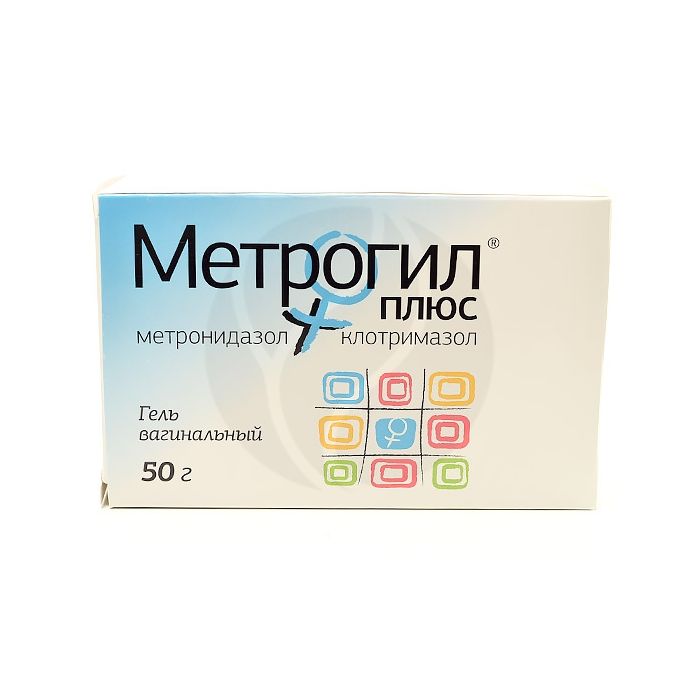Metrogyl plus vaginal gel 1%, 50g with applicator No. 10
Russian Pharmacy name:
Метрогил плюс гель вагинальный 1%, 50г с аппликатором №10
Bacterial vaginosis of various etiologies, confirmed by clinical and microbiological data.
Candidal vulvitis and vulvovaginitis, urogenital trichomoniasis.
Intravaginally.
The recommended dose is 5 g (one full applicator) 2 times a day (morning and evening).
The course of treatment is 5 days.
If necessary, the course of treatment can be repeated after 2 weeks.
One gram of gel contains:
Metronidazole - 10 mg
Clotrimazole - 20 mg
Excipients: methylhydroxybenzoate, propylhydroxybenzoate, disodium edetate, propylene glycol, carbomer-940, benzyl alcohol, sodium hydroxide, purified water
Hypersensitivity to the components of the drug.
Leukopenia (including a history).
Organic damage to the central nervous system (including epilepsy).
Liver failure.
Pregnancy I trimester.
Trade name: METROGILЃPLUS
Dosage form:
Vaginal gel
Composition:
One gram of gel contains:
Metronidazole - 10 mg
Clotrimazole - 20 mg
Excipients: methylhydroxybenzoate, propylhydroxybenzoate, disodium edetate, propylene glycol, carbomer-940, benzyl alcohol, sodium hydroxide, purified water
Description:
Opalescent, homogeneous white or off-white gel
Pharmacotherapeutic group:
Antimicrobial combined agent (antimicrobial and antiprotozoal agent + antifungal agent).
ATX code [G01AF20]
Pharmacological properties
Pharmacodynamics:
Combined drug for intravaginal use, the effectiveness of which is due to the presence of two components in its composition: metronidazole and clotrimazole.
Metronidazole is highly active against protozoa: Entamoeba histolytica, Giardia lamblia, Trichomonas vaginalis , as well as gram-negative anaerobes: Bacteroides fragilis, Fusobacterium spp., Prevotella (P. bivia, P. buccae, P. disiens , some and vaginalis vaginalis), Gram-positive microorganisms: Clostridium perffringens, Clostridium difficile, Peptococcus spp., Peptostreptococcus spp. The minimum inhibitory concentration for these strains is 0.125 - 6.25 ?g / ml.
Clotrimazole is an imidazole derivative. It has a fungicidal and bactericidal effect. It inhibits the biosynthesis of ergosterol, which regulates the permeability of the cell wall of microorganisms. In small concentrations it acts fungistatically, and in large concentrations it is fungicidal. In fungicidal concentrations, it interacts with mitochondrial and peroxidase enzymes, resulting in an increase in the concentration of hydrogen peroxide to a toxic level, which also leads to the death of fungi. Possesses high activity against fungi: Blastomyces dermatitidis, Candida spp., Coccidioides immitis, Cryptococcus neoformans , dermatophytes (Trichophyton mentagrophytes, Microsporum canis, Epidermophyton floccosum), Histoplasma capsulatum, Parasilcoccidioisisii; protozoa: Trichomonas vaginalis; gram-positive bacteria: Streptococcus spp., Staphylococcus spp., Escherichia coli, Klebsiella pneumoniae, Pseudomonas aeruginosa, Proteus mirabilis .
Pharmacokinetics:
After intravaginal administration, metronidazole undergoes systemic absorption (about 56%). The relative bioavailability of the vaginal gel is 2 times higher than the bioavailability of a single dose (500 mg) of vaginal metronidazole tablets. It penetrates into breast milk and most tissues, passes through the blood-brain barrier and the placenta. After a single intravaginal injection of 5 g of gel (50 mg of metronidazole), the average maximum concentration in the serum of healthy women is 237 ng / ml, which is 2% of the average maximum concentration of metronidazole when taken orally with a dose of 500 mg. The time to reach maximum concentration is 6-12 hours. Plasma protein binding is less than 20%. It is metabolized in the liver by hydroxylation, oxidation and glucuronidation.The activity of the main metabolite (2-oxymetronidazole) is 30% of the activity of the parent compound. It is excreted by the kidneys - 60-80% of the dose of the systemic drug (20% of this amount unchanged), by the intestines - 6-15% of the dose of the systemic drug.
When using clotrimazole, no more than 3-10% of the administered dose is absorbed intravaginally. High concentrations in vaginal secretions and low concentrations in blood persist for 48-72 hours. In the liver, clotrimazole is rapidly metabolized to inactive metabolites.
Indications for use:
Bacterial vaginosis of various etiologies, confirmed by clinical and microbiological data.
Candidal vulvitis and vulvovaginitis, urogenital trichomoniasis.
Contraindications:
Hypersensitivity to the components of the drug.
Leukopenia (including a history).
Organic damage to the central nervous system (including epilepsy).
Liver failure.
Pregnancy I trimester.
Pregnancy and lactation:
The use of the drug in the II and III trimester of pregnancy is possible only on strict medical grounds and under medical supervision (without the use of an applicator). When prescribing the drug during lactation, it is necessary to stop breastfeeding.
Methods of administration and dosage:
Intravaginally.
The recommended dose is 5 g (one full applicator) 2 times a day (morning and evening).
The course of treatment is 5 days.
If necessary, the course of treatment can be repeated after 2 weeks.
Side effects:
Local reactions: burning sensation or increased urination; a sexual partner - a burning sensation or irritation of the penis.
The development of systemic effects is possible: dizziness, headache, nausea, spastic pain in the abdominal cavity.
Allergic reactions: skin rash, urticaria.
In case of any unwanted side effects, it is necessary to stop treatment and consult a doctor!
Interaction with other medicinal products:
Similar to disulfiram, it causes intolerance to ethanol.
It enhances the effect of indirect anticoagulants, it is not recommended to combine it with non-depolarizing muscle relaxants (vecuronium).
When taken simultaneously with lithium preparations, the concentration of lithium in the blood plasma may increase.
Phenobarbital accelerates the metabolism of metronidazole due to the induction of microsomal liver enzymes, cymitidine - reduces.
Amphotericin B, nystatin, natamycin reduce the effectiveness of clotrimazole with simultaneous use.
Overdose:
There were no cases of drug overdose when prescribed in recommended doses.
Special instructions:
During the period of treatment, alcohol intake is contraindicated (the development of a disulfiram-like reaction is possible: spastic abdominal pain, nausea, vomiting, headache, sudden flushing of the face).
Metronidazole can immobilize treponemas and lead to a false positive Nelson's test. For intravaginal use only! Avoid contact with eyes!
During the course of treatment, it is necessary to abstain from sexual activity.
Release form:
20 g or 30 g in an aluminum or plastic laminated tube. One tube complete with an applicator and instructions for use in a cardboard box.
Storage:
At a temperature not exceeding 25? —, out of the reach of children.
Shelf life:
2 years.
Do not use after the expiration date printed on the package.
Dispensed from pharmacies: by prescription

